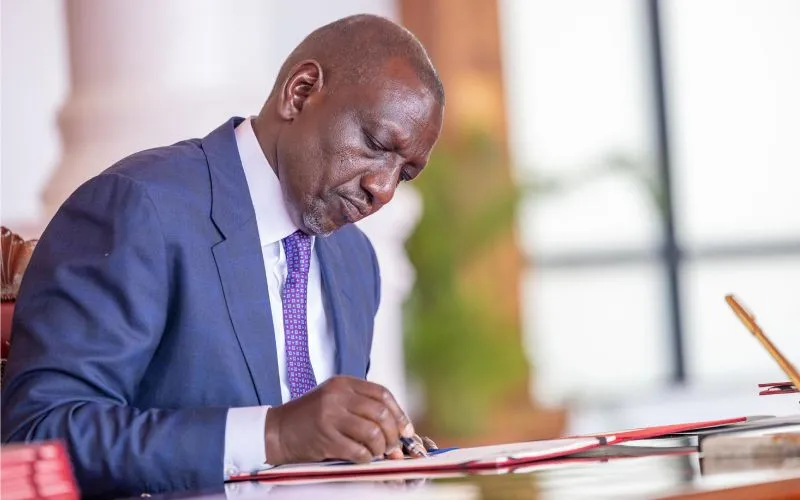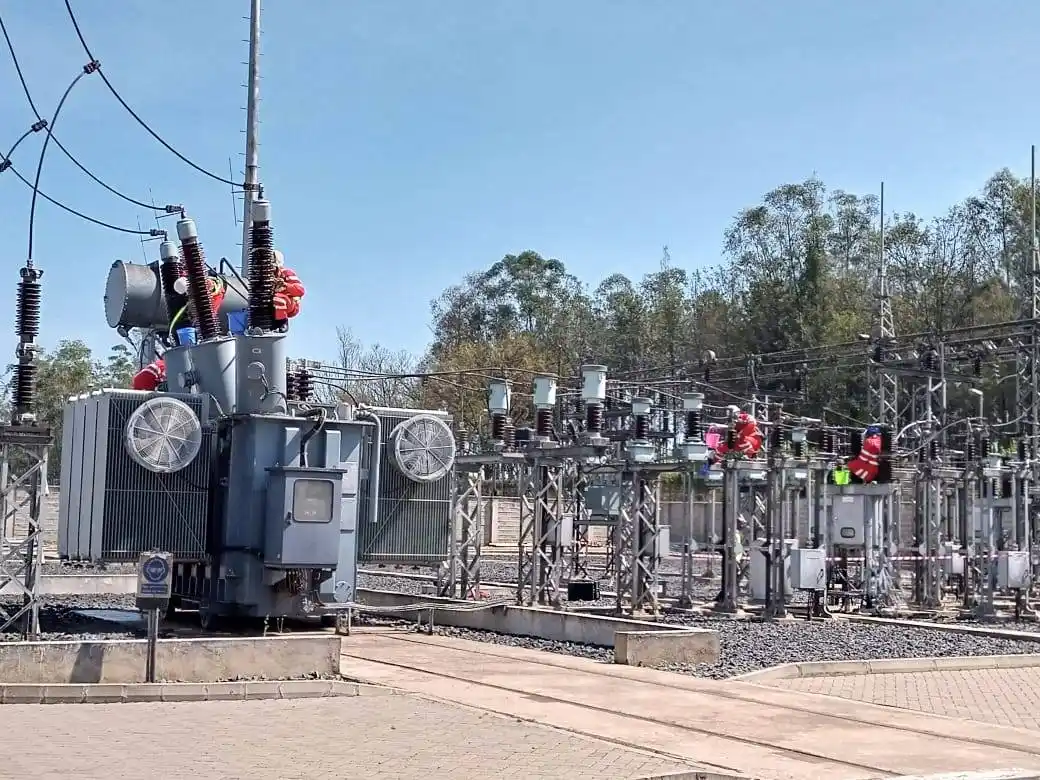In a pivotal moment for Kenya’s economic trajectory, President William Ruto has officially assented to three critical National Assembly Bills: the Finance Bill 2025, the Supplementary Appropriation Bill 2025, and the Appropriations Bill 2025. Signed into law at State House, Nairobi, these legislative instruments collectively define the government’s comprehensive strategy for generating revenue, outlining tax policies, and dictating how public funds will be allocated and spent during the upcoming 2025/2026 fiscal year.
The quiet approval of the 2025 Finance Bill by Members of Parliament last week, with only minimal amendments to the original proposals submitted by the National Treasury on May 6, marks a striking contrast to the fierce public opposition that characterized the passage of similar legislation in the previous year. This year’s smoother legislative journey reflects a careful navigation of public sentiment and fiscal priorities by the current administration.
According to a parliamentary brief, the Finance Bill 2025 introduces targeted amendments to several foundational tax-related statutes, including the Income Tax Act, the Value Added Tax Act, the Excise Duty Act, the Tax Procedures Act, the Miscellaneous Fees and Levies Act, and the Stamp Duty Act. These adjustments are deemed by the government to be indispensable for sustaining its ambitious, and indeed record-breaking, Sh4.2919 trillion (approximately US$33.2 billion) budget. The Ruto administration asserts that these measures are strategically designed to promote local manufacturing, attract much-needed investment, and significantly boost overall national revenue, aligning with Kenya’s broader economic transformation agenda.
While the Finance Bill lays out the mechanisms for revenue generation, the Appropriations Bill details the precise allocation and utilization of these funds. As clarified by the National Assembly, the Appropriations Bill 2025 authorizes the National Treasury to issue a sum of Sh1.8 trillion from the Consolidated Fund for recurrent expenditure in the year ending June 30, 2026. Furthermore, it empowers ministries, departments, and agencies to utilize an additional Sh671 billion as “Appropriation-in-Aid,” representing revenue they collect directly. The overall expenditure framework for FY 2025/2026 includes an allocation of Sh1.8 trillion for recurrent expenditure and Sh744 billion for development expenditure, encompassing allocations to domestic and foreign-financed projects, the Contingency Fund, and the Equalization Fund.
Crucially, significant funding has been directed towards the government’s flagship programs, notably in critical sectors such as health, education, food security, youth empowerment, enhancing access to affordable credit for small businesses, and agriculture. The signing of these bills, in the presence of National Assembly Speaker Moses Wetang’ula and Treasury Cabinet Secretary John Mbadi, solidifies the fiscal roadmap for President Ruto’s administration as it seeks to steer Kenya towards sustained economic growth and development.
The Pillars of Public Finance: Decoding Kenya’s Budgetary Laws
Understanding the significance of President Ruto’s assent requires a grasp of Kenya’s budgetary legislative framework. The three bills signed into law each play a distinct, yet interconnected, role in managing the nation’s finances:
1. The Finance Bill 2025: The Engine of Revenue Generation
The Finance Bill is arguably the most impactful annual piece of legislation, as it dictates the government’s revenue-raising measures for the upcoming fiscal year. It proposes amendments to existing tax laws or introduces new taxes, levies, and fees. For FY 2025/2026, the Finance Bill 2025 introduces several key changes aimed at broadening the tax base, streamlining tax administration, and regularizing inconsistencies within various tax statutes. While the government emphasized no new tax burdens, a closer look reveals specific shifts:
- Income Tax Act Amendments:
- Minimum Top-Up Tax: Clarifies the due date for payment, aligning it with the balance of tax due date (last day of the fourth month after the end of the income year) for multinational enterprises.
- Tax Loss Carryforwards: Introduces a controversial five-year cap on the deductibility of tax losses. Previously, taxpayers could carry forward losses indefinitely. The Bill lacks a transition clause for existing tax losses, creating uncertainty for businesses with accumulated historical losses.
- Expanded Definition of Royalty: Broadens the definition to include the distribution of software where regular payments are made for its use through a distributor, aiming to clarify withholding tax status in this area.
- Per Diem Threshold: Increases the tax-free per diem threshold for employees from KES 2,000 to KES 10,000, offering some relief for employees on official duties.
- PAYE Deductions: Mandates employers to apply all eligible tax reliefs, deductions, and exemptions an employee is entitled to when accounting for Pay As You Earn (PAYE) taxes, potentially simplifying compliance for employees.
- Sports-Related Expenses: While allowing deductibility for expenditures incurred in the construction of a public sports facility, it repeals the provision that allowed deductibility of sports sponsorship expenditures requiring prior Cabinet Secretary approval, impacting corporate sports sponsorship.
- Value Added Tax (VAT) Act and Excise Duty Act: The Bill proposes changes impacting certain commodities and business operations. While the exact details of these changes were minimally amended from the initial proposals, the overarching goal is to enhance revenue collection and align with the government’s Medium Term Revenue Strategy (MTRS).
- Tax Procedures Act and Miscellaneous Fees and Levies Act: Amendments in these areas are largely aimed at improving tax administration and efficiency, alongside the introduction of new fees or levies where deemed necessary.
- Stamp Duty Act: Includes miscellaneous amendments to this Act, which governs taxes on legal documents.
- Significant Economic Presence Tax (SEPT): Expands the scope of SEPT to include income derived or accrued from Kenya through a business carried out via the internet or an electronic network. It also repeals the exemption from SEPT for non-resident persons with an annual turnover of less than KES 5 million. This reflects a continued push to tax the digital economy, following the replacement of the Digital Service Tax (DST) with SEPT in 2024.
- Advance Pricing Agreements (APAs): A new provision, effective January 1, 2026, introduces APAs for transfer pricing purposes. This allows taxpayers to enter into an agreement with the Kenya Revenue Authority (KRA) on specific related-party transactions, aiming to mitigate transfer pricing controversy risks and promote tax certainty for businesses with complex international operations.
- Country-by-Country Reports (CbCR): The Bill proposes to lift the exemption granted to constituent entities of a Multinational Enterprise (MNE) Group from filing a country-by-country report where there is a competent authority agreement on the exchange of information. This move enhances transparency in international taxation.
While the government has projected revenue collection of KES 3,321.8 billion for FY 2025/26 (including KES 2,754.7 billion in ordinary revenue and KES 567.0 billion in Ministerial Appropriation-in-Aid), the effectiveness of these new tax measures in achieving the ambitious Sh4.2 trillion budget target will be closely monitored.
2. The Appropriations Bill 2025: Guiding Public Expenditure
The Appropriations Bill is the legal instrument that authorizes the National Treasury to withdraw funds from the Consolidated Fund to finance government expenditures for the fiscal year. It essentially translates the approved budget estimates into law, giving ministries, departments, and agencies (MDAs) the legal authority to spend.
For FY 2025/2026, the Bill authorizes the expenditure of Sh1.8 trillion for recurrent expenses (salaries, operational costs, debt servicing) and Sh744 billion for development projects (infrastructure, investments). Additionally, MDAs are permitted to utilize Sh671 billion in Appropriation-in-Aid, which represents funds collected directly by these entities (e.g., fees for services, licenses). This structure ensures that both day-to-day operations and long-term development initiatives are adequately funded.
3. The Supplementary Appropriation Bill 2025: Adjusting Mid-Cycle
While the news brief mentions the Supplementary Appropriation Bill 2025, its content is usually about adjusting the current year’s budget. Typically, a Supplementary Appropriation Bill is introduced mid-fiscal year to adjust the allocations made in the initial Appropriations Act. This becomes necessary due to unforeseen circumstances, changes in government priorities, or revisions in revenue forecasts. It allows the government to reallocate funds or seek additional spending authority. The signing of a Supplementary Bill for 2025, alongside the main budget for 2025/2026, suggests that the current fiscal year (2024/2025) likely required some adjustments to its spending plan.
The Sh4.2 Trillion Budget: Ambition Meets Fiscal Realities
The Sh4.2919 trillion budget for FY 2025/2026 represents the largest in Kenya’s history, reflecting the Ruto administration’s ambitious development agenda under its Bottom-Up Economic Transformation Agenda (BETA). This budget, presented by Treasury Cabinet Secretary John Mbadi Ng’ongo, aims to revive the economy, create jobs, and support small businesses, with a strong focus on uplifting the lives of ordinary Kenyans.
The theme of the 2025/2026 budget statement is “Sustaining Bottom-up Economic Transformation Agenda, Fiscal Consolidation and Investing in Climate Change Mitigation and Adaptation for Improved Livelihoods.” This highlights a dual focus: driving economic growth through targeted interventions while simultaneously addressing the country’s significant fiscal challenges. The government’s stated goals for the budget include upholding macroeconomic stability, enhancing national security, accelerating infrastructure development (roads, railways, energy, water), increasing investments in agriculture, manufacturing, environmental conservation, tourism, and boosting social sectors like health and education.
Despite the ambitious spending plan, the projected total revenue collection, including grants, for FY 2025/26 is KES 3,321.8 billion. This leaves a fiscal deficit of KES 923.2 billion, which will largely be financed by net external borrowing of KES 287.7 billion and net domestic borrowing of KES 635.5 billion. The government’s fiscal policy for FY 2025/26 emphasizes fiscal consolidation, aiming to reduce the fiscal deficit from 5.7% of GDP in FY 2024/25 to 4.8% of GDP in FY 2025/26. This is part of a broader strategy to slow public debt growth and improve debt sustainability, with a target to reduce the debt-to-GDP ratio from an estimated 63.0% in 2024 towards the 55% ± 5% range by 2028.
Investing in People and Productivity: Flagship Programs and Allocations
The budget for FY 2025/2026 prioritizes several key sectors and flagship programs, reflecting the core pillars of the Bottom-Up Economic Transformation Agenda (BETA). These interventions are designed to create jobs, reduce the cost of living, eradicate hunger, expand the tax base, and improve foreign exchange balances.
1. Education: The Largest Share of the Pie
The education sector continues to receive the largest allocation, underscoring its critical role in human capital development and national progress. A staggering Sh702.7 billion has been set aside for education in FY 2025/26. This includes significant allocations for:
- Teachers Service Commission (TSC): Sh387.2 billion, primarily for teacher salaries and welfare.
- Junior Secondary School (JSS): Sh28.9 billion for capitation and Sh7.2 billion for hiring intern teachers, addressing the ongoing transition to the Competency-Based Curriculum (CBC).
- CBC Training: Sh980 million for training teachers on the new curriculum.
- Free Primary and Secondary Education: Sh7 billion for Free Primary Education and Sh51.9 billion for Free Day Secondary Education, ensuring access to basic education.
- Higher Education: The Higher Education Loans Board (HELB) receives an increased allocation of Sh41.5 billion, supporting student loans. University student scholarships get Sh16.9 billion, while Technical and Vocational Education and Training (TVET) institutions receive Sh7.7 billion in scholarships and capitation, reflecting a push towards skills development.
- Infrastructure: Sh1.7 billion for primary and secondary school infrastructure and Sh1.4 billion for constructing and equipping vocational centers.
2. Healthcare and Social Protection: Towards Universal Coverage
The health sector has been allocated Sh138.1 billion, reflecting the government’s commitment to advancing Universal Health Coverage (UHC). Key allocations include:
- Primary Healthcare: Sh13.1 billion to strengthen primary healthcare services, the foundation of UHC.
- UHC Coordination: Sh6.2 billion for coordinating UHC initiatives.
- Medical Insurance for Vulnerable Groups: Sh430 million for medical cover targeting orphans, the elderly, and persons with disabilities.
- Disease Control: Sh17.3 billion for the Global Fund to address HIV, malaria, and tuberculosis, and Sh4.6 billion for vaccines and immunization programs.
- Emergency Fund: The Emergency, Chronic and Critical Illnesses Fund will receive Sh8 billion, an increase from the previous year, to cater to pressing medical needs.
- Specialized Care: Allocations for cancer care (Kenyatta National Hospital, Kenyatta University Teaching, Referral and Research Hospital), referral hospitals (Moi Teaching and Referral, Mwai Kibaki, Jaramogi Oginga Odinga), and a burns and pediatric center at Kenyatta National Hospital.
- Medical Personnel: Sh4.3 billion for medical interns, Sh3.2 billion for community health promoters, and Sh8.9 billion for the Kenya Medical Training Centre, emphasizing human resource development in health. The budget also notes that more than 22 million Kenyans have registered with the newly established Social Health Authority, indicating progress in health financing reforms.
3. Food Security and Agriculture
The budget prioritizes increased investments in agriculture, a core pillar of BETA aimed at eradicating hunger and reducing the cost of living. While a specific aggregate figure for agriculture was not immediately available, the sector’s interventions typically focus on:
- Subsidized Inputs: Ensuring affordable fertilizers and certified seeds for farmers.
- Extension Services: Providing technical support and training to boost productivity.
- Value Addition: Supporting agro-processing to enhance farmer incomes.
- Irrigation: Investing in irrigation projects to reduce reliance on rain-fed agriculture.
4. Micro, Small and Medium Enterprises (MSMEs) and Youth Empowerment
A significant focus is placed on the MSME economy and youth, seen as crucial for job creation and inclusive growth.
- Transforming MSME Economy: Allocated Sh47.6 billion.
- Hustler Fund: An additional Sh300 million has been allocated to the Hustler Fund, which has already provided affordable credit to over 26 million Kenyans, primarily youth and MSMEs, fostering entrepreneurship at the grassroots level.
- Youth Enterprise Development Fund: Sh308 million for youth-led ventures.
- Entrepreneurship Centers: Sh550 million to support the establishment and operation of entrepreneurship centers.
- Rural Financial Inclusion: Sh1.3 billion to enhance financial access in rural areas.
5. Housing and Settlement
The housing sector, another BETA pillar, received Sh128.3 billion to promote affordable housing. This investment is not only aimed at providing decent housing but also at generating significant employment opportunities in the construction sector and stimulating local manufacturing of building materials.
6. Digital Superhighway and Creative Economy
The government’s vision for a digital economy is supported by an allocation of Sh12.7 billion for the Digital Superhighway and Creative Economy. This funding targets:
- ICT Infrastructure: Developing robust digital infrastructure across the country.
- Digital Hubs: Establishing hubs to foster innovation and digital skills.
- Creative Economy: Supporting youth employment in digital jobs, music, design, and animation, leveraging Kenya’s burgeoning tech and creative talent.
A Striking Contrast: Lessons from the Finance Bill 2024 Protests
The relatively calm passage of the Finance Bill 2025 stands in stark contrast to the tumultuous events surrounding the Finance Bill 2024 (then called Finance Bill 2023). Last year, Kenya witnessed unprecedented, widespread, and largely youth-led mass protests under the rallying cry #RejectFinanceBill2024.
The previous year’s bill had ignited public fury due to several highly contentious tax proposals, including:
- 16% VAT on bread: A staple food item, this proposal was seen as directly impacting the poor and middle class.
- 2.5% annual motor vehicle tax: This was widely criticized for applying to all vehicles, regardless of whether they generated income, adding another layer of taxation.
- Increased mobile money transfer fees: Affecting daily transactions for millions of Kenyans, particularly those in the informal sector.
- Doubling of the housing levy: A mandatory deduction from gross salary, deemed inequitable and lacking a clear legal framework at the time.
The protests, which began peacefully in Nairobi on June 18, 2024, quickly spread nationwide. Mobilized primarily through social media platforms like X (formerly Twitter), TikTok, and Instagram, Kenyan youth demonstrated an unprecedented level of civic engagement. The peaceful demonstrations escalated into violent clashes with security forces, culminating on June 25, 2024, when protesters stormed the Parliament buildings. This resulted in tragic consequences, with at least 22 deaths and numerous injuries as police opened fire on the crowd.
The sheer scale and intensity of the public backlash forced President Ruto to withdraw the Finance Bill 2024 on June 28, 2024. However, the anger lingered, with protests escalating further, this time demanding the President’s resignation amidst widespread accusations of police brutality, abductions, torture, and extrajudicial killings of protesters. Concerns were also raised about the government’s approach to public participation, transparency, and accountability in developing tax measures, with many arguing that the proposals lacked a clear rationale and fair implementation. The International Monetary Fund (IMF) was often cited by critics as a driving force behind the proposed tax increases, given Kenya’s need for fiscal consolidation.
The experience of Finance Bill 2024 likely played a significant role in the administration’s approach to the 2025 bill. The government appears to have engaged in more extensive dialogue, carefully considered public feedback, and possibly presented proposals that were perceived as less burdensome or more aligned with public expectations, thereby averting a repeat of last year’s widespread unrest. This shift signals a crucial learning curve for the government in navigating the delicate balance between fiscal responsibility and public acceptance.
Navigating Kenya’s Fiscal Landscape: Challenges and Outlook
The signing of the Finance Bill 2025 and the accompanying Appropriations Bills comes at a critical juncture for Kenya’s economy, which continues to grapple with significant fiscal challenges.
The Debt Burden
Kenya faces a high risk of debt distress. As of June 2024, the total public debt stood at Kshs 10.6 trillion (approximately US$81.8 billion), equivalent to 70.0% of GDP. This figure significantly exceeds the International Monetary Fund (IMF) threshold of 50.0% for developing countries, highlighting the urgency of fiscal reforms. The debt service to revenue ratio hit an alarming 101.4% in July 2023, indicating that almost all government revenue was going towards servicing debt, severely constraining resources for essential services and development projects.
The government has been actively engaged in fiscal consolidation efforts, aiming to reduce the budget deficit and curb debt accumulation. This includes a shift towards external borrowing to alleviate pressure on domestic interest rates and a successful partial buyback of a $2.0 billion Eurobond in February 2024, a move aimed at assuring foreign investors of Kenya’s commitment to debt sustainability. However, reducing debt requires a careful balance between revenue mobilization and expenditure control without hurting service delivery or imposing undue taxation pressure on citizens.
Revenue Mobilization and Expenditure Rationalization
The government’s fiscal strategy, as outlined in the Medium Term Revenue Strategy (MTRS), aims to increase the ordinary revenue-to-GDP ratio from 14.1% in FY 2022/23 to 20% by FY 2025/26 and further to 25% by 2030. This ambitious target relies heavily on the tax administrative and policy measures introduced in the Finance Bill. However, historical trends show that perennial increases in tax rates have often yielded minimal increases in ordinary revenue as a share of GDP, indicating challenges in effective collection and compliance.
On the expenditure side, the government has committed to expenditure rationalization, focusing on improving efficiency and reducing wastage of public resources. This includes measures like auditing payrolls to eliminate “ghost workers” and better targeting of subsidies. However, observers note that these cuts often fall short of the required fiscal adjustment, necessitating continued reliance on borrowing.
Economic Outlook
Despite the fiscal pressures, Kenya’s economy has demonstrated resilience, with a projected economic growth rate of 5.3% in 2025 and sustained momentum over the medium term. This growth is largely driven by enhanced agricultural productivity, a resilient services sector, and the ongoing implementation of priorities under the BETA agenda. The Finance Bill 2025 and the accompanying budget aim to support this growth by directing resources to productive sectors and social safety nets.
However, the efficacy of the government’s fiscal consolidation agenda will be crucial for long-term economic stability. Successfully broadening the tax base, improving tax compliance, and rationalizing expenditures while also attracting more foreign direct investment will determine whether Kenya can achieve its ambitious development goals without spiraling into unsustainable debt. The signing of these bills marks a firm declaration of the government’s chosen path, and their impact will unfold as the new fiscal year commences.
Conclusion: A New Chapter in Kenya’s Fiscal Governance
The signing of the Finance Bill 2025, Supplementary Appropriation Bill 2025, and Appropriations Bill 2025 into law by President William Ruto represents a defining moment in Kenya’s fiscal governance. This comprehensive legislative package lays out the government’s strategy for revenue generation and expenditure for the 2025/2026 fiscal year, supporting an ambitious Sh4.2 trillion budget underpinned by the Bottom-Up Economic Transformation Agenda.
The relatively smooth passage of this year’s Finance Bill, in stark contrast to the widespread protests of 2024, highlights a crucial shift in the political landscape and potentially a more refined approach by the administration in engaging with public sentiment. While the new tax measures aim to broaden the tax base and streamline administration, their ultimate impact on citizens and businesses will depend on effective implementation and consistent economic growth.
With significant allocations directed towards education, health, food security, youth empowerment, MSMEs, and digital transformation, the budget demonstrates a clear commitment to human capital development and inclusive growth. However, the inherent challenge of managing a high public debt burden and achieving ambitious revenue targets will continue to define Kenya’s fiscal journey. The success of these laws will be measured not just in collected revenues or allocated funds, but in their tangible impact on the livelihoods of millions of Kenyans and the country’s trajectory towards sustainable economic prosperity.
Ready to take your career to the next level? Join our dynamic courses: ACCA, HESI A2, ATI TEAS 7 , HESI EXIT , NCLEX – RN and NCLEX – PN, Financial Literacy!🌟 Dive into a world of opportunities and empower yourself for success. Explore more at Serrari Ed and start your exciting journey today! ✨
photo source: Google
By: Montel Kamau
Serrari Financial Analyst
27th June, 2025
Article, Financial and News Disclaimer
The Value of a Financial Advisor
While this article offers valuable insights, it is essential to recognize that personal finance can be highly complex and unique to each individual. A financial advisor provides professional expertise and personalized guidance to help you make well-informed decisions tailored to your specific circumstances and goals.
Beyond offering knowledge, a financial advisor serves as a trusted partner to help you stay disciplined, avoid common pitfalls, and remain focused on your long-term objectives. Their perspective and experience can complement your own efforts, enhancing your financial well-being and ensuring a more confident approach to managing your finances.
Disclaimer: This article is for informational purposes only and does not constitute financial advice. Readers are encouraged to consult a licensed financial advisor to obtain guidance specific to their financial situation.
Article and News Disclaimer
The information provided on www.serrarigroup.com is for general informational purposes only. While we strive to keep the information up to date and accurate, we make no representations or warranties of any kind, express or implied, about the completeness, accuracy, reliability, suitability, or availability with respect to the website or the information, products, services, or related graphics contained on the website for any purpose. Any reliance you place on such information is therefore strictly at your own risk.
www.serrarigroup.com is not responsible for any errors or omissions, or for the results obtained from the use of this information. All information on the website is provided on an as-is basis, with no guarantee of completeness, accuracy, timeliness, or of the results obtained from the use of this information, and without warranty of any kind, express or implied, including but not limited to warranties of performance, merchantability, and fitness for a particular purpose.
In no event will www.serrarigroup.com be liable to you or anyone else for any decision made or action taken in reliance on the information provided on the website or for any consequential, special, or similar damages, even if advised of the possibility of such damages.
The articles, news, and information presented on www.serrarigroup.com reflect the opinions of the respective authors and contributors and do not necessarily represent the views of the website or its management. Any views or opinions expressed are solely those of the individual authors and do not represent the website's views or opinions as a whole.
The content on www.serrarigroup.com may include links to external websites, which are provided for convenience and informational purposes only. We have no control over the nature, content, and availability of those sites. The inclusion of any links does not necessarily imply a recommendation or endorsement of the views expressed within them.
Every effort is made to keep the website up and running smoothly. However, www.serrarigroup.com takes no responsibility for, and will not be liable for, the website being temporarily unavailable due to technical issues beyond our control.
Please note that laws, regulations, and information can change rapidly, and we advise you to conduct further research and seek professional advice when necessary.
By using www.serrarigroup.com, you agree to this disclaimer and its terms. If you do not agree with this disclaimer, please do not use the website.
www.serrarigroup.com, reserves the right to update, modify, or remove any part of this disclaimer without prior notice. It is your responsibility to review this disclaimer periodically for changes.
Serrari Group 2025












